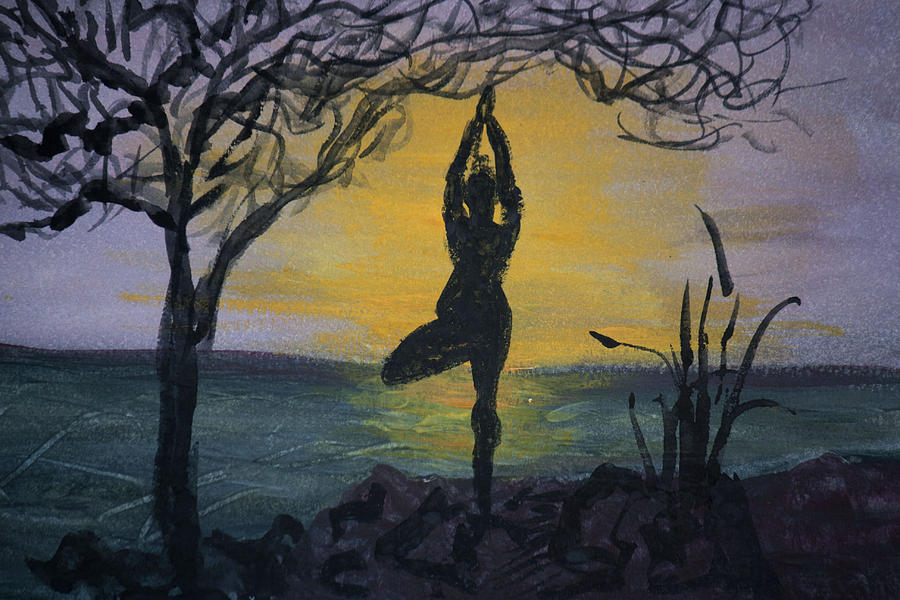Poems for
yoga (1972-1973)
1)
my eyes fly
like the sun
down southern cliffs
foam climbs
my ankles, puppy fond for touch
seagulls in grey regiment watch the sea
while I step
around their single-glitter eyes
the sun comes on me now like a lover
quietly she
slips my body into her embrace
2)
before me now
dark cloud
has marshaled half the evening sky
it ponders beside a deep edge of stars
a huge map, land against ocean
I wander that cloud
as the cliff-face of a continent
freshening
myself in the space-sea at my side;
I would embark in a ship of lives
leaving the darkness behind me.
3)
bowing into mudra
I enter the silent world
a blade of
grass leans within the sun
an insect crawls across my back;
the other
world offers me its noisy thoughts
highway and plane, chain saw and radio
but I drift on slow breaths
to the trees and quiet birds
nature's
song sweeps the noises into a corner
I am the grass
4)
birds murmur
gently beside my silence
as I look into the spring
the night was cold upon their
tongues;
I roll the air from the purple sea
inside my lungs, inside my mind's
chattering
a hinge opens
eyes within eyes begin to take
notice
5)
the moon
wanders quickly
this January afternoon
a sidelong
sway with the wind
it is nearly
full, feet tucked under
a fondness
from summer, warm embrace;
something
licks down my insides o Moon
you sail the night sky
stars booming like pianos
and my legs
itch, my ears open
6)
today I walk
down leaves and shadows, sun-pools dance beside me
a fence green-heavy with peas
beyond this
a garden waits upon my smiling eyes
I climb some
boughs and look to the coast
spray of
whales and combers in triangles, moths of the sea
the land is
blue: it winks like a mind and curves like a ship;
now I stand ankles in the air at the summit
of my world
what is left
but to fly as the aeriest creature of my delight?
7)
the sea
moves upon the land like a wrinkling skin
steppes of
huge water led by the flying white mares
combers hungry for the sand and their joy:
within each of us a continent,
with all a blue ocean
8)
sometimes
the spring visits
for an hour, a morning
birds merry
their conversation and light grows thicker
the robust crows float aaark's to the sea
and allysum
sweetens the air for my drinking
now the year is stretching in a yawn
thrusting out a leg
it is blinking and awakening
slowly arousing from dreams
9)
I span a
streamy sea, a vortex of old
sinews in
the rusty blood, arrows driven
down a
congregation of whores and tongues
that roll to
lick the sheets of winking glass
all hidden
underneath the brown and hazing brain
that breaks
and thunders in the motor-children past

Yoga Tree Pose -- Donna Walsh
A mudrā (Sanskrit for "seal," "mark," or "gesture") is a symbolic or ritual gesture and an energetic seal of authenticity employed in the iconography and spiritual practice of Indian religions. Some involve the entire body, but most use only the hands and fingers.
ReplyDeleteIn yoga, mudras are used in conjunction with breathing exercises, generally while seated, to stimulate different parts of the body that are affected by breathing. Regular Tantric yoga uses 108 mudras. Hatha ("force") yoga (or Haṭhavidyā) is a system of physical techniques designed by the deity Shiva that has become popular around the world, especially the asanas (physical postures) as a form of physical exercise; it is what is generally referred to generically as "yoga." According to Svāmi Svātmārāma's 15th-century classic "Hatha Yoga Pradīpikā (Light on Hatha Yoga), "The goddess sleeping at the entrance of Brahma's door should be constantly aroused with all effort, by performing mudra thoroughly." In Indian classical dance, the term "hasta mudra" is used. The "Abhinaya Darpana" gives 28 mudras, while the "Nāṭyaśāstra" describes 24 of them. The 2nd-century "Abhinaya Darpana" (The Mirror of Gesture) was written by Nandikeshvara, whom some sources regard as Bharata Muni's mentor; Bharata's "Nāṭyaśāstra" (Nat" [act, represent] + "Shastra" [precept, rules, manual, compendium, book, treatise]) was compiled sometime between 500 BCE and 500 CE (probably, a bit more narrowly, between 200 BCE and 200 CE). Its 36 chapters contain 6000 verses (perhaps 1/2 its original length) on dramatic composition, the structure of a play, stage construction, genres of acting, body movements, make up, costumes, the role of an art director, musical scales and instruments, the integration of music with art, and its Rasa aesthetic theory which asserts that entertainment is a secondary goal of performance arts: the primary goal is to transport the audience into a parallel reality where they experience the essence of their own consciousness and reflect on spiritual and moral questions. Oḍiśī, which originated in Odisha, the oldest surviving dance form in India, was called "Odra-Magadhi" in the "Nāṭyaśāstra;" it has only 20 hasta mudra. Bharata Natyam (or Bharathanatiyam), originated in the temples of Tamil Nadu and was based on the "Nāṭyaśāstra," but it developed its distinct style between the 3rd century BCE and the 4th century CE in ancient Tamilakam; it employs 28 (or 32) root mudras. Kathakali, a stylized dance-drama genre noted for its elaborate make-up and costumes, detailed gestures, and well-defined body movements, originated in Kerala during the 17th century but with roots going back to folk dances that are almost 1500 years old; it has 24 hasta mudra. These root mudras are combined in different ways, like one hand, two hands, arm movements, body and facial expressions, and so forth; Kathakali has about 900 combinations.